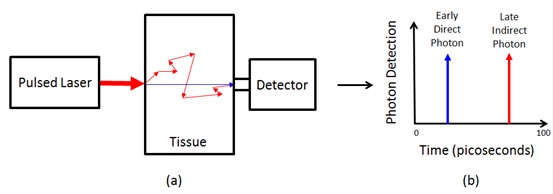The Early Photon Gets the Worm
The Early Photon Gets the Worm
Ken Tichauer
Under those circumstances we could just reconstruct images based on the direct photons to produce a higher resolution image, potentially pushing the limits microscopy in thicker tissues. Conceptually, this doesn’t appear to be too difficult: perhaps if the light was pulsed in a very narrow time window, then the photons that arrived earliest at the detector must have taken the most direct route, while the photons that arrive later, must have taken the more indirect route. Simple idea; however, implementation of this idea is not so straight forward owing to the incredibly high temporal resolution and fast lasers needed to carry out this approach. Preliminary improvements in optical tomography have now been demonstrated in mouse experiments,1 and in zebra fish.2
In our lab, we are exploring ways to push the limits of early photon detection – i.e., trying to isolate the earliest, most direct photons possible – by accounting for laser and detection signal dispersion effects.3 Advances in this area will help us apply our quantitative molecular imaging strategies4 at high-resolution in cancers to explore the interplay between drug resistance and tumor molecular heterogeneity in preclinical experiments to guide drug discovery.

1 Niedre, M. J. et al. Early photon tomography allows fluorescence detection of lung carcinomas and disease progression in mice in vivo. Proceedings of the National Academy of Sciences of the United States of America 105, 19126-19131, doi:10.1073/pnas.0804798105 (2008).
2 Bassi, A. et al. Time-gated optical projection tomography. Optics letters 35, 2732-2734, doi:10.1364/OL.35.002732 (2010).
3 Diop, M. & St Lawrence, K. Deconvolution method for recovering the photon time-of-flight distribution from time-resolved measurements. Optics letters 37, 2358-2360, doi:10.1364/OL.37.002358 (2012).
4 Tichauer, K. M. et al. In vivo quantification of tumor receptor binding potential with dual-reporter molecular imaging. Molecular imaging and biology : MIB : the official publication of the Academy of Molecular Imaging 14, 584-592, doi:10.1007/s11307-011-0534-y (2012).
